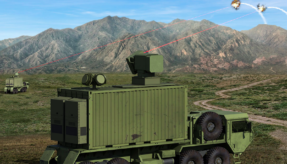
General Atomics Electromagnetic Systems (GA-EMS) announced that it has partnered with the US Space Development Agency (SDA) to demonstrate and conduct a series of experiments for an Optical Intersatellite Link (OISL) utilising GA-EMS’s internally developed 1550nm (nanometer) wavelength laser communication terminals (LCTs).
This will be one of the first Department of Defense contracted efforts to develop and deploy a state-of-the-art 1550nm LCT to test capabilities to increase the speed, distance, and variability of communications in space.
“This is an exciting opportunity for GA-EMS to leverage work currently underway to advance OISL technologies,” stated Scott Forney, president of GA-EMS. “For several years we have been developing a series of optical laser communication terminals to improve and increase satellite crosslink data transfer rates and downlink data rates. These experiments will demonstrate robust communication capabilities through multiple mediums, from Earth, to and between satellites in multiple orbits, and on in to deep space. Our LCT technology will modernise and enhance space communications permitting faster communication transmission across longer distances and with greater fidelity.”
The Optical Intersatellite Link demonstration will consist of two GA-EMS internally designed and built 12U CubeSat spacecraft, each of which will host an Infrared payload (IRPL) and LCT payload, with an anticipated launch date in March 2021. Satellite development, integration and testing is being conducted at GA-EMS facilities in San Diego, CA and Huntsville, AL. GA-EMS will also provide mission control capabilities from its mission control centres in Centennial, CO and Huntsville.
“GA-EMS’ small satellite designs offer unique solutions to many of the challenges that arise when developing demonstration assets such as LCTs including addressing specific size, weight, and power requirements,” said Nick Bucci, vice president of Missile Defense and Space Systems at GA-EMS. “With our proven spacecraft and their capabilities coupled with our significant investment in LCT research and development, we anticipate this demonstration to show data rates up to 5GB a second at ranges up to 2500 km, and this LCT can support out to greater than 4500 km. This increased speed in communications is necessary to advance a variety of space applications in intelligence, surveillance, telecommunications, reconnaissance, and more.”
If you would like to join our community and read more articles like this then please click here.
General Atomics Electromagnetic Systems US Department of Defense US Space Development Agency







